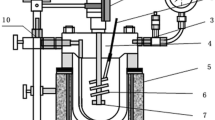Abstract
The highly-alkaline red mud, which is the Bayer process residue generated from the alumina industry, is a severe environmental problem. In this study, a new calcification–carbonation process was proposed for red mud disposal. Red mud was processed by lime to convert the aqueous silicon phase into hydrogarnet, which was then decomposed by CO2 to recover alumina. In the direct carbonation process, the NaOH-containing solution after calcification was directly carbonated without prior liquid–solid separation. The discrete and direct carbonation processes had alumina recovery rates of 34.9 and 35.5%, respectively, with 0.15 and 0.21 wt % Na2O in the final red muds, respectively. The optimum NaOH concentration in the calcification liquor was 30 g/L. Under these conditions, alumina recovery was increased to 44.5% and the Na2O concentration in the processed red mud was reduced to <1 wt %. The final red mud can be used as a construction material.
Similar content being viewed by others
References
Zhu, X.F., Zhang, T.A., Wang, Y.X., Lv, G.Z., and Zhang, W.G., Recovery of alkali and alumina from Bayer red mud by the calcification-carbonation method, Int. J. Min. Met. Mater., 2016, vol. 23, no. 3, pp. 257–268.
Agatzini-Leonardou, S., Oustadakis, P., Tsakiridis, P.E., and Markopoulos, Ch., Titanium leaching from red mud by diluted sulfuric acid at atmospheric pressure, J. Hazard. Mater., 2008, vol. 157, nos. 2–3, pp. 579–586.
Power, G, Gräfe, M., and Klauber, C., Bauxite residue issues: I. Current management, disposal and storage practices, Hydrometallurgy, 2011, vol. 108, nos. 1–2, pp. 33–45.
Liu, W.C. Study on the Multiphase Transformation of Bayer Red Mud in the High Temperature Roasting Reaction and Recovery of Iron Aluminum and Sodium, Dissertation, Huazhong Univ. Sci. Technol., Wuhan, 2010, p.9.
Klauber, C., Gräfe, M., and Power, G., Bauxite residue issues: II. Options for residue utilization, Hydrometallurgy, 2011, vol. 108, nos. 1–2, pp. 11–32.
Qin, S. and Wu, B.L., Effect of self-glazing on reducing the radioactivity levels of red mud based ceramic materials, J. Hazard. Mater., 2011, vol. 198, pp. 269–274.
Tsakiridis, P.E., Agatzini-Leonardou, S., and Oustadakis, P., Red mud addition in the raw meal for the production of Portland cement clinker, J. Hazard. Mater., 2004, vol. 116, nos. 1–2, pp. 103–110.
Tor, A., Danaoglu, N., Arslan, G., and Cengeloglu, Y., Removal of fluoride from water by using granular red mud: Batch and column studies, J. Hazard. Mater., 2009, vol. 164, no. 1, pp. 271–278.
Gray, C.W., Dunham, S.J., Dennis, P.G., Zhao, F.J., and McGrath, S.P., Field evaluation of in situ remediation of a heavy metal contaminated soil using lime and red-mud, Enviton. Pollut., 2006, vol. 142, no. 3, pp. 530–539.
Liu, W.C., Sun, S.Y., Zhang, L., Jahanshahi, S., and Yang, J.K., Experimental and simulative study on phase transformation in Bayer red mud soda-lime roasting system and recovery of Al, Na and Fe, Miner. Eng., 2012, vol. 39, pp. 213–218.
Tanutrov, I.N., Sviridova, M.N. and Savenya, A.N., A new technology for coprocessing man-made wastes, Russ. J. Non-Ferrous Met., 2013, vol. 54, no. 2, pp. 136–142.
Zhong, L., Zhang, Y.F., and Zhang, Y., Extraction of alumina and sodium oxide from red mud by a mild hydro-chemical process, J. Hazard. Mater., 2009, vol. 172, nos. 2–3, 1629–1634.
Lv, G.Z., Zhang, T.A., Zhu., X.F., Liu, Y., Wang, Y.X., and Guo, F.F., Zhao, Q.Y., and Zheng, C.Z., Calcification–carbonation method for cleaner alumina production and CO2 utilization, JOM, 2014, vol. 66, no. 9, pp. 1616–1621.
Zhao, Q.Y., Zhu, X.F., Lv, G.Z., Zhang, Z.M., Yin, Z.N., and Zhang, T.A., Calcification transformation of diasporic bauxite, JOM, 2016, vol. 68, no. 6, pp. 1711–1716.
Rivas Mercury, J.M., Pena, P., De Aza, A.H., Turrillas, X., Sobrados, I., and Sanz, J., Solid-state 27Al and 29Si NMR investigations of Si-substituted hydrogarnets, Acta Mater., 2007, vol. 55, no. 4, pp. 1183–1191.
You, S.W., Zhang, Y.F., Chen, F.F., Cao, S.T., and Zhang, Y., Transformation of NaCaHSiO4 to sodalite and katoite in sodium aluminate solution, Hydrometallurgy, 2014, vol. 141, pp. 43–48.
Frost, R.L., López, A., Scholz, R., Sampaio, N.P., and de Oliveira, F.A., SEM, EDS and vibrational spectroscopic study of dawsonite NaAl(CO3)(OH)2, Spectrochim. Acta A., 2015, vol. 136, no. PB, pp. 918–923.
Bi., S.W., Alumina production process, Chemical Ind., Beijing, 2010, p. 282.
Author information
Authors and Affiliations
Corresponding author
Additional information
The article is published in the original.
About this article
Cite this article
Xie, LQ., Zhang, TA., Lv, GZ. et al. Direct Calcification–Carbonation Method for Processing of Bayer Process Red Mud. Russ. J. Non-ferrous Metals 59, 142–147 (2018). https://doi.org/10.3103/S1067821218020050
Received:
Accepted:
Published:
Issue Date:
DOI: https://doi.org/10.3103/S1067821218020050




